7.8 /10 1 Votes
3.8/5 Google Play | Composer(s) Nobuyuki Ohnogi Initial release date 1981 Genre Shoot 'em up | |||||||||||||||||||||||||||||||||
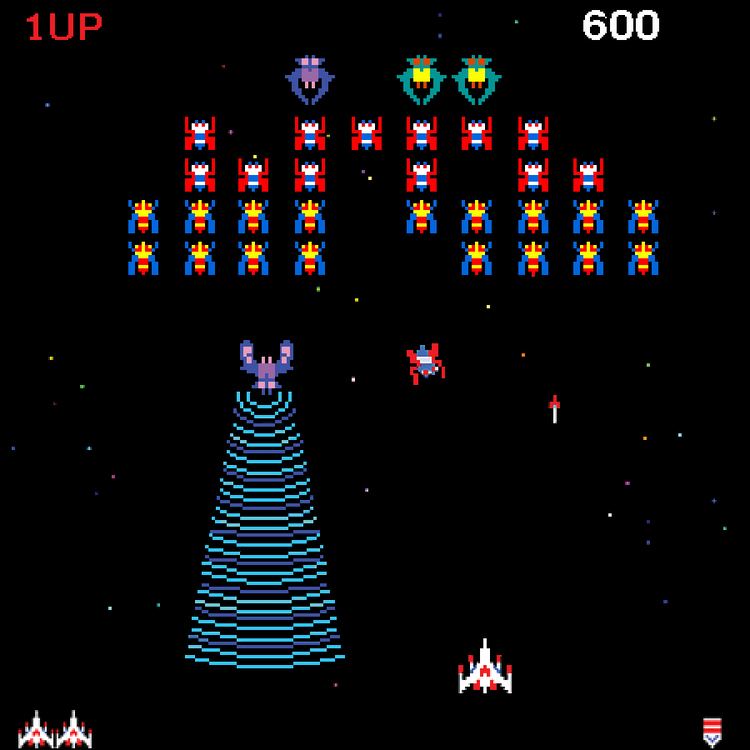 | ||||||||||||||||||||||||||||||||||
Release date(s) JP: September 1981NA: December 1981 Cabinet Upright, cabaret, and cocktail CPU 3x ZiLOG Z80 @ 3.072 MHz Publishers Namco, Atari, Bandai, Bandai Namco Entertainment Similar Galaxian games, Atari games, Shoot 'em up games | ||||||||||||||||||||||||||||||||||
Galaga classic arcade game
Galaga (ギャラガ, Gyaraga) is a Japanese shoot-'em-up arcade game developed and published by Namco Japan and by Midway in North America in 1981. It is the sequel to 1979's Galaxian. The gameplay of Galaga puts the player in control of a spacecraft which is situated at the bottom of the screen, with enemy aliens arriving in formation at the beginning of a stage, either trying to destroy, collide, or capture the spaceship, with the player progressing every time alien forces are vanquished.
Contents
- Galaga classic arcade game
- Gameplay
- Release history
- Remakes
- Reception and legacy
- Records
- Galaga in popular culture
- Film
- Video game
- References
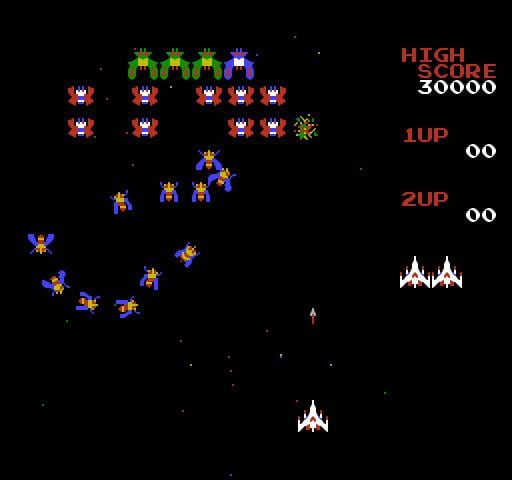
Galaga is one of the most commercially and critically successful games from the golden age of arcade video games. The arcade version of it has been ported to many consoles, and it has had several sequels. In 2011, the game celebrated its 30th anniversary with the release of Galaga 30th Collection for iOS.
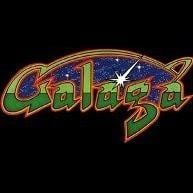
Gameplay
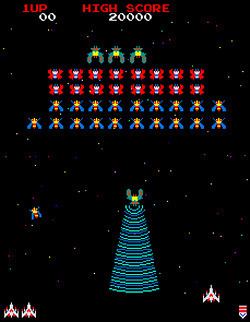
The objective of Galaga is to score as many points as possible by destroying insect-like enemies. The player controls a starfighter that can move left and right along the bottom of the playfield. Enemies swarm in groups in a formation near the top of the screen, and then begin flying down toward the player, firing bullets at and attempting to crash into them. In later stages, some enemies even break from an entering group in a frantic attempt to crash into the player. The game ends when the player's last fighter is lost by colliding with an enemy, being hit by an enemy shot, or being captured.

Galaga introduces new features from its predecessor, Galaxian. Among these are the ability to fire two shots in succession rather than one, a "hit/miss ratio" statistic at the end of the game, and a bonus "Challenging Stage" that occurs every few stages, in which a series of enemies fly onto and off the screen in set patterns without firing at the player's ship or trying to crash into it. When you destroy a group of enemies, you are awarded 1500 points. These stages award a 10K-point bonus if the player manages to destroy every enemy, but otherwise 100 bonus points for every enemy destroyed.
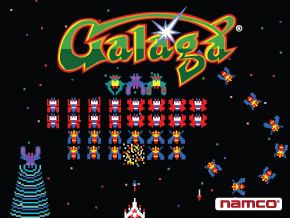
Another gameplay feature new to Galaga is the ability for enemies to capture the player's fighter. While the player is in control of just one fighter, a "boss" Galaga (which takes two hits to kill) will periodically attempt to capture the fighter using a tractor beam. If successful, the fighter joins the enemy formation as a satellite to the boss Galaga which captured it. The captive fighter becomes an enemy, turns red, and likewise, it can be shot and destroyed. The player can still fire while being captured up to the point their ship "touches" the captor, which could be considered an opportunity to shoot the captor down before it can manage to successfully capture the player. Captive fighters can be freed by destroying the boss Galaga towing it while it is attacking. The freed fighter will then combine with the player's fighter who freed them, offering doubled firepower but with the disadvantage of a target twice as large. If the player destroys the captor while it is still in formation, the captured fighter will not be rescued, and will instead fly away after a diving run (assuming the player does not destroy it) to appear in the next stage as a satellite for another boss Galaga where it can again be rescued.
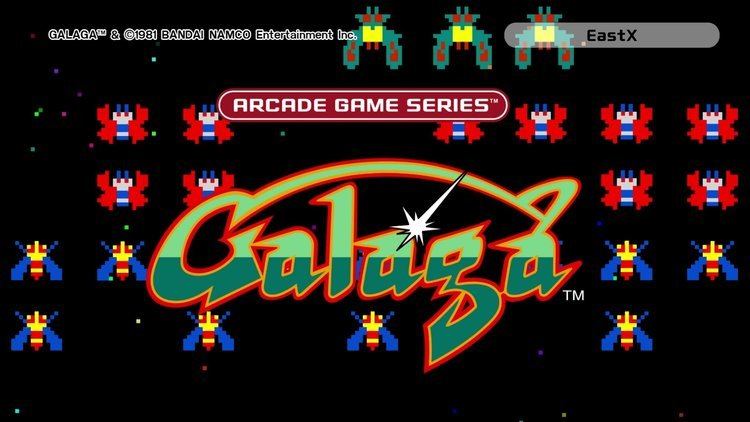
Galaga has an exploitable bug that can cause the attackers to stop firing shots at the player. In addition, similar to the famous "Split-Screen bug" in Pac-Man, a bug exists in Galaga in which the game "rolls over" from Stage 255 to Stage 0. Depending on the difficulty setting of the machine, this can cause the game to stall, requiring that the machine be reset or power-cycled in order to start a new game.
Release history
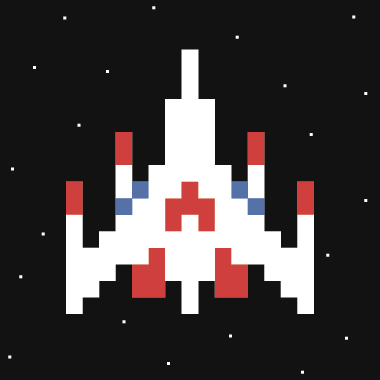
- Galaxian (1979)
- Galaga (1981)
- Gaplus (also known as Galaga 3) (1984)
- Galaga '88 (1987)
- Galaga '90 (1988) (a re-release of Galaga 88 for the TurboGrafx-16)
- Galaxian³ (1990)
- Galaga 2 (1991) (a re-release of Galaga 88 for the Game Gear, called Galaga '91 in Japan)
- Attack of the Zolgear (1994)
- Galaga Arrangement (1995) (released as part of Namco Classic Collection Vol. 1)
- Galaga Arrangement (2005) (released as part of Namco Museum Battle Collection)
- Galaga Remix (2007) (released as part of Namco Museum Remix and Namco Museum Megamix)
- Galaga Legions (2008)
- Galaga Remix (2009) (a renamed port of Galaga Arrangement from Namco Museum Battle Collection)
- Galaga Special Edition (2010)
- Galaga 30th Collection (2011)
- Galaga Legions DX (2011)
- Galaga 3D Impact (2011)
- Space Galaga (2014) (Space Dandy themed)
- Galaga: TEKKEN Edition (2015)
- Galaga Assault (2016)
- Galaga Wars (2016)
The original arcade version of Galaga has been ported to several systems. These include:
The game has been re-released on the following systems:
Galaga has also been released as part of the Namco Museum series of collections across several platforms:
Galaga was used as a side game during the loading stage of the PlayStation port of Tekken in 1995. This version consisted entirely of challenging stages. In Point Blank 2, there are a few Galaga challenging stages where the player must shoot a certain amount of enemies to complete the stage. In 2001, Namco released a "20 Year Reunion / Class of 1981" arcade unit which contained the original Ms. Pac-Man and Galaga games. Some of the original game's bugs are still present in this version, including the ability to stop all enemies from firing at the player. This version added a continue feature, when the player's lives are exhausted, the player can choose to continue or start over. The game was later released as part of the Pac-Man's Arcade Party arcade machine in 2010.
Namco began releasing Galaga on mobile platforms in 2004. The game is available for play on most game-enabled cell phones, Palm devices and Pocket PCs. In celebration of the 25th anniversary of the game, Sprint is also offering their wireless subscribers the chance to start the game in Dual Fighter Mode.
Galaga is also one of the bonus arcade games included in the Wii and Nintendo 3DS versions of Pac-Man Party.
Remakes
In 1995, Namco re-released Galaga along with an enhanced remake titled Galaga Arrangement, which features a number of graphical enhancements and gameplay differences from the original. Galaga Arrangement has subsequently been published as part of the Namco Museum compilation on several home video game consoles. Another remake, Galaga: Destination Earth, was released in 1998 for Windows, the PlayStation, and the Game Boy Color.
A Galaga Remix game was part of the 2007 Wii compilation Namco Museum Remix and its 2010 follow-up compilation, Namco Museum Megamix, but its gameplay completely unlike that of the original—the Wii Remote is used as a gun, and players must "protect Pac-Man as he rolls through space, and quickly shoot down invading forces before they attack him."
Galaga, along with Galaxian, Gaplus, and Galaga '88, was "redesigned and modernized" for an iPhone app compilation called the Galaga 30th Collection, released in commemoration of the event by Namco Bandai.
A free-to-play Galaga game based on the anime and manga Space Dandy, was announced under the name Space Galaga. The game follows Meow on a quest to capture rare aliens and has the same mechanics as the original arcade game. Additions to this game include free customization of the Aloha Oe and multiplayer competitive versus. It is released for Apple and Android smartphones.
Reception and legacy
AllGame rated the arcade version 5 out of 5 stars. Famicom Tsūshin scored the Game Boy version of the game a 24 out of 40 upon release. The NES version received a score of 80% from Joystick upon release, and later 8 out of 10 from GameSpy.
In an article on MAME-based arcade game emulation, Games magazine's Eric Berlin placed Galaga among his top 7 best holding-up titles from the past, and he described the game as one of the few titles of the era to add new twists to the Space Invaders formula by allowing the aliens to capture your ship. Game Informer ranked it the 19th best video game in 2001. The staff felt that it was still the best shooter of its kind. It has been included among the best video games of all time by various other publications, including Electronic Gaming Monthly (in 1997, 2001 and 2006), G4, GameFAQs (in 2004 and 2009), GameSpy, GameTrailers, IGN, Killer List of Videogames, and Time magazine.
Records
The world record highest score for Galaga was set in June 1989 by Stephen Krogman of Boca Raton, Florida. Krogman scored 15,999,990 points based on Marathon settings. On January 1, 2011, Andrew Laidlaw of Kirkland, Washington, achieved a world record high score of 4,525,150 points on the much harder Tournament settings. The Rapid-Fire settings (depression of the fire button causing continuous shooting) world record is held by Jon E. Klinkel of Battle Creek, Michigan, with a world record high score of 3,210,590 points.
In 2001, Namco released Ms. Pacman / Galaga Class of 1981 as part of a compilation. The world record highest score for Galaga based on the Fast-Shoot Speed settings (where bullets are fired at a much faster rate than the original fire version) is held by Daniel Rodriguez of Hialeah, Florida, who achieved 4,300,360 points.
Galaga in popular culture
In 1983, shortly after Galaga was released in the United States, MGM sent a Galaga machine to Matthew Broderick for him to practice prior to shooting the movie WarGames. He practiced for two months and the Galaga arcade unit makes two appearances in the film.
Galaga sound effects can be heard as background noise in an arcade on the CHiPs episode "High Times", which aired on January 16, 1983.
In 2007, the ABC TV series Lost included a submarine named Galaga, in honor of the arcade game. Writers of the series would often play the game between writing sessions.
In 2009, the Hallmark greeting card company released a Christmas tree ornament shaped like a Galaga arcade machine, complete with sound clips from the game.
In the 2013 novel University, set in the 1980s, one segment focuses on a marathon Galaga session, with wheelchair-bound freshman Dwight Manning making a run at the then-existing world record.
Film
Galaga appeared in the following movies: WarGames (1983), The Karate Kid (1984), Planes, Trains and Automobiles (1987), and Pixels (2015) as the first game that attacks.
Galaga appeared briefly in 2012's The Avengers. Upon entering S.H.I.E.L.D.'s Helicarrier, Tony Stark catches an agent playing Galaga and remarks, "That man is playing Galaga. Thought we wouldn't notice, but we did." After the Avengers' team meeting, the agent returns to his game.
Video game
The Galaga boss is an Assist Trophy in Super Smash Bros. for Nintendo 3DS and Wii U. Players can throw the boss at enemies, and the boss will then proceed to use its tractor beam to lift the opponents away.
